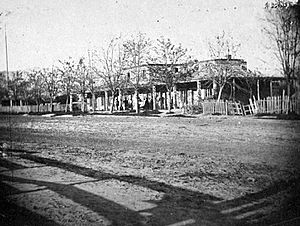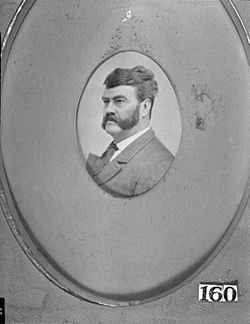O. M. Wozencraft facts for kids
Oliver M. Wozencraft (born July 26, 1814 – died November 22, 1887) was an important early settler in California. He played a big part in making agreements, called treaties, between the United States government and the Native American tribes in California. Later, Wozencraft also worked on a plan to bring water to a dry area of California known as the Imperial Valley.
Contents
Life Story
Early Years
Oliver Wozencraft was born in Clermont County, Ohio, on June 26, 1814. He studied medicine and became a doctor, graduating from St. Joseph's College in Kentucky.
In 1837, he married Lamiza A. Ramsey in Nashville, Tennessee. In 1848, after a serious sickness called a cholera epidemic hit, he moved to Brownsville, Texas. He left his wife and three young children behind in New Orleans.
After another cholera outbreak in Texas in 1849, Wozencraft heard exciting news about gold in California. He decided to go there to find his fortune. He arrived in California in May 1849, after a tough journey across the Colorado Desert.
California's First Constitution
Wozencraft settled in Stockton, California. Soon after, he was chosen to be a representative for the San Joaquin area at the California Constitutional Convention in Monterey in 1849.
This convention was a meeting where leaders decided how California would be governed. They wrote the state's first constitution. Wozencraft signed this important document on October 13, 1849.
Working with Native Americans
On July 8, 1850, the President of the United States, Millard Fillmore, appointed Wozencraft as an "Indian Agent." This meant he was a government official who worked with Native American tribes. At first, he didn't get paid for this job.
Later, in October 1850, Wozencraft, along with two other men named Redick McKee and George W. Barbour, became "commissioners." Their job was to make treaties (formal agreements) with different Native American tribes in California. For this role, Wozencraft was paid eight dollars a day, plus money for his travels.
Between March 1851 and January 1852, Wozencraft and the other commissioners traveled all over California. They negotiated 18 treaties with various Native American tribes. These treaties were sent to the United States Senate for approval in June 1852.
However, the Senate decided not to approve these treaties. They kept the treaties secret from the public until 1905. President Fillmore ended Wozencraft's role as an Indian Agent in August 1852.
Bringing Water to Imperial Valley
Wozencraft strongly believed in a plan to bring water from the Colorado River to a very dry area called the Salton Sink. This area is now known as the Imperial Valley. He thought a canal could use gravity to move the water.
Around 1854, he hired a surveyor to map out a path for this canal. In 1859, Wozencraft successfully convinced the California State Legislature to set aside a large amount of land (about 3 million acres) in the Colorado Desert for his water project.
To get the money needed to build the canal, Wozencraft needed the U.S. Congress to pass a special law. He spent the rest of his life trying to get this law passed, but he was never successful.
Death and Legacy

Oliver Wozencraft died from a heart attack on November 22, 1887, in Washington, D.C. He was there to try one more time to get his Imperial Valley water bill approved by Congress. Sadly, the bill was rejected just before he passed away. Some people in Congress thought his idea was just a "fantastic folly of an old man."
Even though Wozencraft didn't see his dream come true, work on a similar canal, the Alamo Canal, began 13 years after his death. This canal eventually brought water to the Imperial Valley, much like Wozencraft had first suggested almost 50 years earlier. Because of his early vision, he is sometimes called the "Father of the Imperial Valley."
Today, people look back at the treaties Wozencraft helped negotiate with California Native Americans. Many now believe these treaties were not fair or well-planned. One evaluation said the process was "a farce from beginning to end." Even in the 1800s, some people thought Wozencraft and the other commissioners didn't know enough about the land or the Native Americans. They felt the treaties were not useful and caused many problems.
Oliver Wozencraft is buried at the San Bernardino Pioneer Memorial Cemetery.



